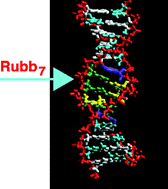Richard Keene and colleagues report an inert dinuclear polypyridylruthenium(II) groove binding metal complex that exhibits slow exchange DNA binding in this HOT article. Such compounds have potential as anti-microbial agents as they can block the interaction of important proteins with DNA.
For more details, download the article which is free to access for 4 weeks.
An approach to therapeutic agents through selective targeting of destabilised nucleic acid duplex sequences
Fangfei Li, Daniel K. Weber, Joy L. Morgan, J. Grant Collins and F. Richard Keene
Dalton Trans., 2012
DOI: 10.1039/C2DT12146H
This paper is part of forthcoming themed issue on Application of Inorganic Chemistry for non-Cancer Therapeutics. Here are some other articles due to be published in this issue….
Interference of a new cyclometallated Pt compound with Cu binding to amyloid-ß peptide
Isabelle Sasaki , Christian Bijani , Sonia Ladeira , Valérie Bourdon , Peter Faller and Christelle Hureau
Dalton Trans., 2012
DOI: 10.1039/C2DT12177H
In vitro inhibitory properties of ferrocene-substituted chalcones and aurones on bacterial and human cell cultures
Keshri Nath Tiwari, Jean-Philippe Monserrat, Arnaud Hequet, Carine Ganem-Elbaz, Thierry Cresteil, Gérard Jaouen, Anne Vessières, Elizabeth A. Hillard and Claude Jolivalt
Dalton Trans., 2012
DOI: 10.1039/C2DT12180H
Polyanionic N-donor ligands as chelating agents in transition metal complexes: synthesis, structural characterization and antiviral properties against HIV
Sandra García-Gallego, Javier Sánchez Rodríguez, José Luis Jiménez, Michela Cangiotti, Maria Francesca Ottaviani, M. Ángeles Muñoz-Fernández, Rafael Gómez and F. Javier de la Mata
Dalton Trans., 2012
DOI: 10.1039/C2DT11793B











